Thirteen sketchbook ideas that make drawings stand out include sketching everyday objects from funky angles, drawing trees or leaves with wild textures, and capturing people or animals in action—maybe mid-jump or zipping by on a bike. Creating a themed series, mashing up mixed media like watercolor with markers, or reimagining famous artworks puts a fresh twist on old subjects. Add in expressive lines, bold colors, and scenes from city life, and every page gets packed with energy. The next ideas might surprise you!
Key Takeaways
- Sketch everyday objects from unique angles or unusual perspectives to add interest and creativity.
- Create thematic series by drawing the same subject multiple times with varied styles or mashups.
- Explore nature close-ups, focusing on textures of bark, leaves, or seasonal changes to inspire fresh sketches.
- Experiment with mixed media and unconventional tools for unexpected textures and visual effects.
- Design expressive characters or abstract patterns, playing with bold lines, varied shapes, and emotional color palettes.
Drawing Everyday Objects With Unique Perspectives
Even though a pencil or a hairbrush might not seem like the most exciting thing to draw, looking at everyday objects from unusual angles can turn them into awesome subjects for a sketchbook.
Imagine sketching your socks from a worm’s-eye view or capturing a stapler as if you’re an ant climbing over it—suddenly, it’s way cooler!
Drawing things like USB drives, video game controllers, or even random stuff from your fridge helps you practice your observation skills and notice details you’ve totally missed before.
By flipping and arranging these objects in unexpected ways, each drawing feels fresh and surprising.
These kinds of sketchbook ideas make something simple seem wild and new, pushing creativity through different shapes, forms, and dynamic compositions you totally control.
Exploring Nature: Trees, Leaves, and Textures
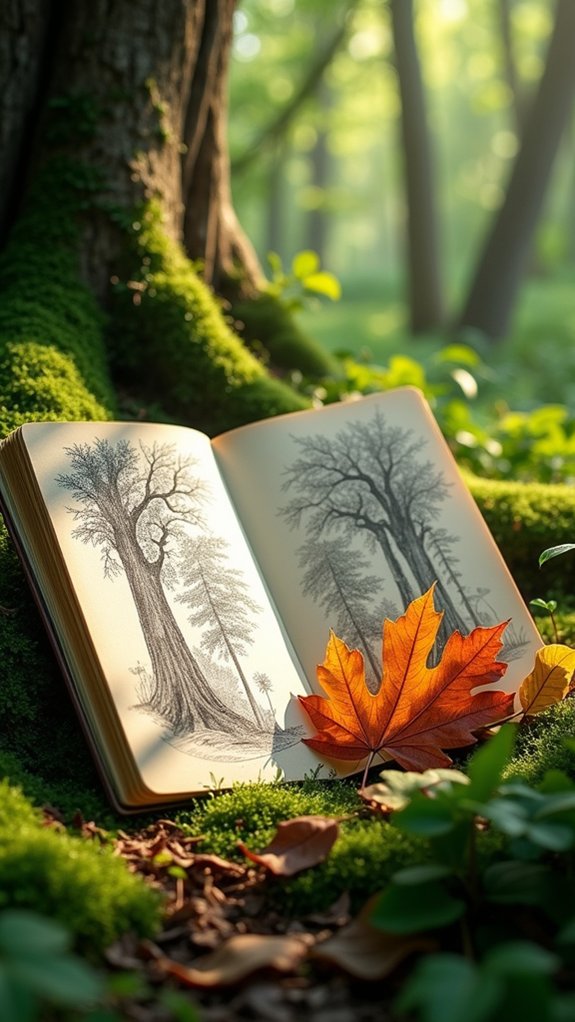
Nature sketches can be seriously exciting when looking at all the wild textures hiding in trees and leaves. Think about it—trees aren’t just tall green things with trunks. Every tree has its own weird bark patterns, knotty branches, and wild shapes.
When someone draws the same tree a few times, new details jump out, almost like the tree is showing off! Leaves have their own cool stuff, too—spiky edges and crazy vein patterns just asking to be sketched.
Using stuff like charcoal or soft pencils, those tiny textures pop, making sketches feel super real. And if you really pay attention to how the light hits the leaves or twists around tree bark, your art can almost glow.
Mix close-ups of leaves with big tree sketches for an epic nature story!
Capturing Motion: Dynamic Scene Sketches
Capturing motion in a sketchbook is all about using wild, energetic lines—think of the way a scribble can show speed or a zigzag can make things look like they’re zooming.
Gesture drawing is a bit like a warm-up sprint for artists, focusing more on the action than the details, and honestly, it can make even a boring stick figure look like a superhero in a chase.
Plus, setting your scene with bold angles or tilted perspectives gives your drawing the kind of excitement that makes someone say, “Whoa, I can almost feel the wind.”
Conveying Movement With Lines
Zip, swoosh, swish—the world is always moving, and so can the lines in a sketchbook. Conveying movement isn’t about being super careful and perfect; it’s about letting loose!
Artists use thick, thin, wild, and even zigzag lines, all going different directions, to give their drawings an energy boost. If you want a soccer ball to look fast, try quickly drawing blur lines or use overlapping shapes for action.
Grab reference photos—like runners or leaping dogs—to study how real action looks. Even drawing the same skater in several poses across a page creates a sense of rhythm.
Don’t be afraid to let your hand zip across the paper. Remember, your sketchbook is a playground for lines in motion!
Expressive Gesture Drawing
Launch into the wild world of expressive gesture drawing, where lines dance, swoop, and swirl across the page, almost as if they have a mind of their own.
Gesture drawing isn’t about perfection—it’s about catching the zing and motion in a quick sketch before it slips away. Artists grab a soft pencil or some charcoal, then tackle moving figures in just 30 seconds or two minutes tops.
No time to fuss over tiny details here! Instead, the focus is on the form and flow, capturing wild energy with bold, loose lines.
Trying out different angles—maybe from above, below, or squished at a weird perspective—makes things even more exciting. It’s a fantastic way to fill a sketchbook with lively, action-packed drawings.
Action Through Composition
When an artist wants to make a drawing feel like it’s bursting with motion, the secret weapon is composition. Forget boring straight lines—diagonal lines and dynamic angles are where the action lives. They send your eyes zooming across the page like a skateboarder on a mission.
Want to crank up the drama? Overlapping elements add instant depth and make it look like things are flying right at you (don’t duck, it’s just a drawing!). Playing with line weight and texture gives subjects a whoosh of speed—fast things look lighter and blurry, steady things feel heavier.
Motion lines? Absolutely! They show direction and energy like comic books do. Try out quick thumbnail sketches first, so you find the best way to make your action really jump off the page.
Repeat Drawing: Developing a Thematic Series
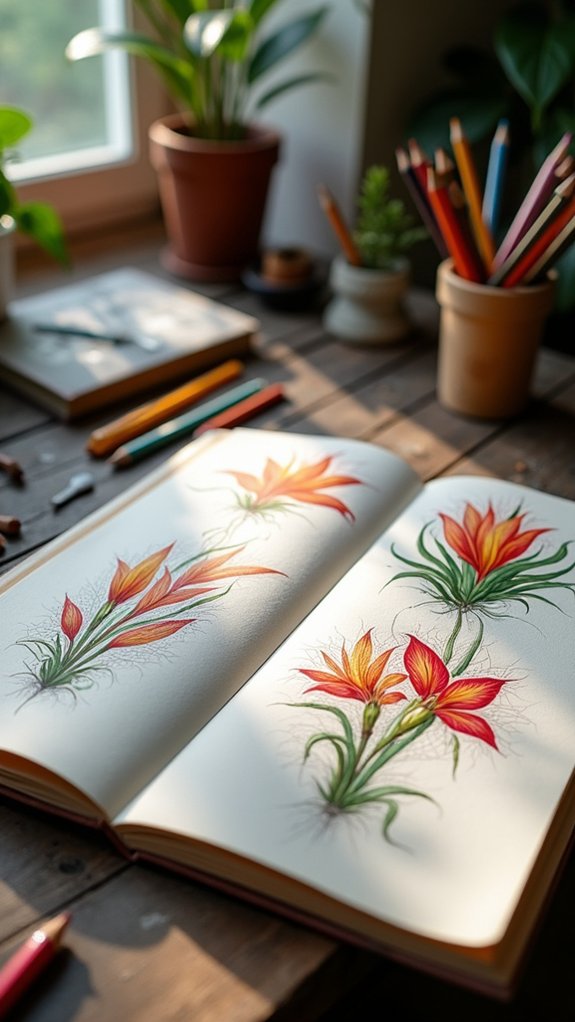
Repeating a theme, like drawing a bunch of trees over and over, is kind of like hitting “replay” on your favorite song to catch new details each time.
Artists get to spot the cool parts they love, mix together the best sections from their series, and see how their style shifts as they go.
It’s a bit like being a detective—tracking changes, swapping out tools, and sometimes ending up somewhere totally unexpected (but way more fun than losing your pencil again).
Exploring Recurring Visual Motifs
Trees, suns, lightning bolts—artists sure love giving their sketchbooks a bit of déjà vu. There’s real magic in exploring a recurring subject over and over again.
Repetition isn’t just about doodling the same thing; it’s about digging a little deeper each time. Sketching a subject like a tree in fifty wild ways sharpens observation skills and opens up new doors for creative growth.
Thumbnails—tiny, rough versions—can help spot which shapes, colors, or branches feel the most “you.” Every time an artist redraws a motif, they get a little braver with materials or switch up their style.
Some tries might flop, but that’s all part of the fun! Iterating like this turns even the humblest sketchbook into a personal gold mine.
Combining Favorite Series Elements
Staring at a sketchbook filled with quirky trees, dramatic suns, or zigzag lightning bolts can spark a late-night “aha!” moment—favorite bits from all those drawings start jumping out.
Suddenly, it’s like playing a favorite video game where you get to combine cool power-ups. By combining favorite series elements on a single sketchbook page, artists—yes, even the reluctant doodlers—create a mashup that feels both personal and epic.
Sketching thumbnails first helps mix and match, like rearranging puzzle pieces to find the best fit. Maybe it’s a gnarly tree with lightning bolt branches and a sun glowing behind.
Experimenting with fresh markers or paints adds surprise twists, making each new spread exciting. That’s how a random sketchbook page can transform into a full-blown, original series!
Evolving Through Repetitive Practice
Immerse yourself in the world of repeating themes, and sketchbooks suddenly turn into secret training grounds for the brain and hand.
When someone chooses a single subject—like a funky tree or a favorite sneaker—and redraws it over and over, something magical happens. Every swirl or line becomes a chance to notice what works and what doesn’t.
This repetitive practice not only helps find fresh drawing ideas, but it also builds skills fast, like artistic superpowers! Mistakes? No worries. They’re just stepping stones to improvement, and sometimes, the quirks make things cooler.
- Try drawing a theme a bunch of times—notice amazing changes!
- Use small thumbnail sketches to experiment without the stress.
- Study what details you love and blend them together.
- Let loose and welcome some wild, unexpected results!
Experimenting With Mixed Media and Unusual Tools
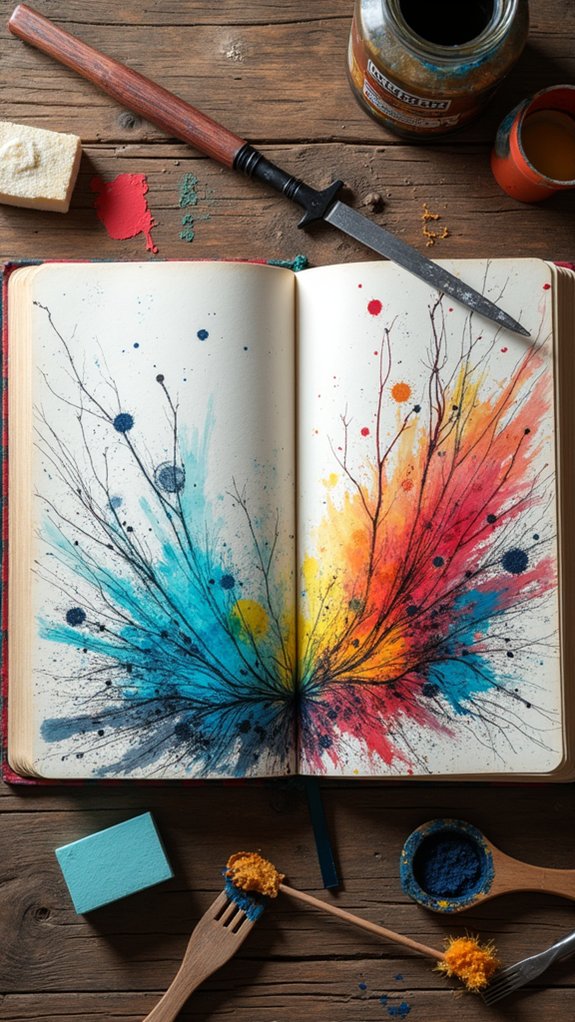
Even though drawing usually means grabbing a pencil or pen, who says that’s all you can use? Enter the world of mixed media and unconventional tools, where art rules go out the window and experimentation is the name of the game.
Want to make your sketches pop? Try splattering watercolor with a toothbrush, pressing ink onto paper using sponges, or even smudging color with your fingers—messy hands are a badge of honor!
Throw in some fabric scraps or weird magazine cutouts and suddenly your art tells its own wild story. Working with oddball materials reveals new textures and surprises, making every page feel like an adventure.
Drawing From Reference Images and Combining Sources
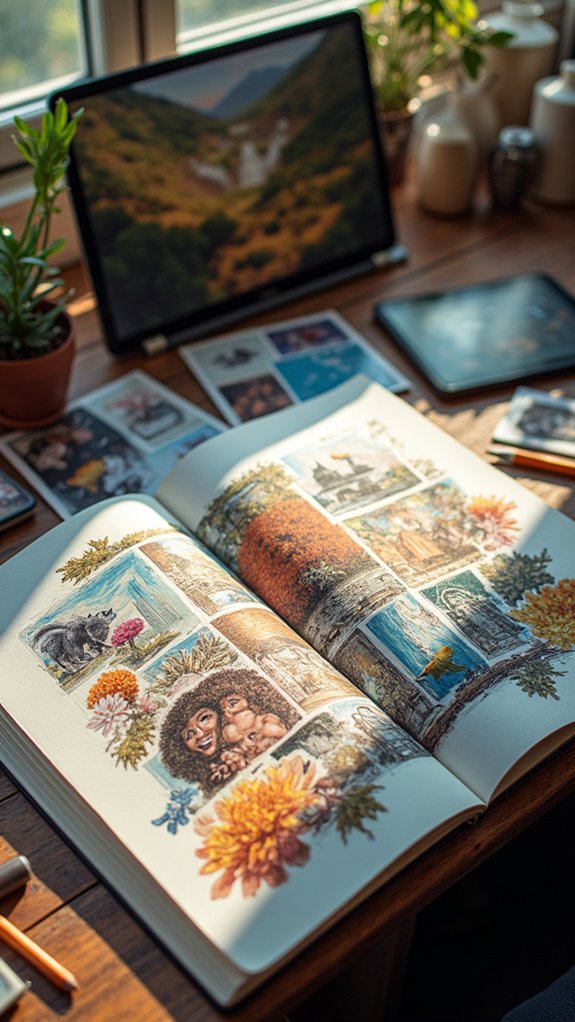
Looking for that perfect spark? Drawing from reference images, whether it’s a cool photo from your own stash or something wild found online, can be a total game-changer—especially when you grab pieces from several images and mash them up into something new.
It’s not about copying every detail like a robot; instead, it’s a chance to twist things your way, add a dash of your own weird sense of style, and see where your imagination takes you.
Sourcing Inspiring Reference Material
When searching for art ideas, reference images are like secret doors that can open up whole new worlds for sketchbook drawings. Whether an artist prefers snapping their own photos or scouring the web, there’s inspiration everywhere.
Sitting on the sofa with art supplies scattered around, it’s easy to scroll through sites like Unsplash or Pexels—each photo a fresh possibility. Instead of copying, giving images a loose twist can help signature styles shine. Sometimes, even the first page of search results can spark a whole adventure of ideas.
Plus, mixing different references—say, that dog with a funky background—keeps things fun and surprising.
- Browse Unsplash or Pexels for endless reference images
- Snap personal photos for a unique source
- Flip through art books at home
- Doodle during comfy, relaxed drawing sessions
Mixing Multiple Image Elements
Mash up an old photo of a friend’s dog with a wild beach sunset, and watch ordinary sketches blast off into something totally unexpected.
Mixing multiple image elements is like making your own comic book world—grab snaps from your phone or royalty-free pics from Unsplash and Pexels.
Try referencing your favorite moments, even if the dog ends up surfing on pink waves!
To avoid a total art disaster, play with different angles and compositions by sketching quick thumbnails.
See where the weirdest, coolest combos show up.
Focus on blending textures, colors, and shapes from each source image, but don’t panic about making it look real.
Grab ideas from the first page of any photo search—fresh inspiration is always a few clicks away.
Interpreting References Creatively
Splicing together wild image combos can totally flip your sketchbook on its head, but even the best mashups start with a killer reference or two.
Interpreting references isn’t about copying every single pixel—it’s about letting creative freedom run wild. Grabbing personal snapshots or snatching royalty-free pics from Unsplash and Pexels, anyone can gather cool stuff to spark new ideas.
But the trick? Combine shots of weird things—a flamingo with a skateboard, maybe?—and let your own style take over. Inspiration can come from the very first page of image results, too, so no need to dig deep.
- Grab references from your own camera roll
- Mix and mash elements from different images
- Experiment with fun drawing materials
- Let your imagination remix reality for unique sketches
Creating Abstract Art Using Shapes and Patterns
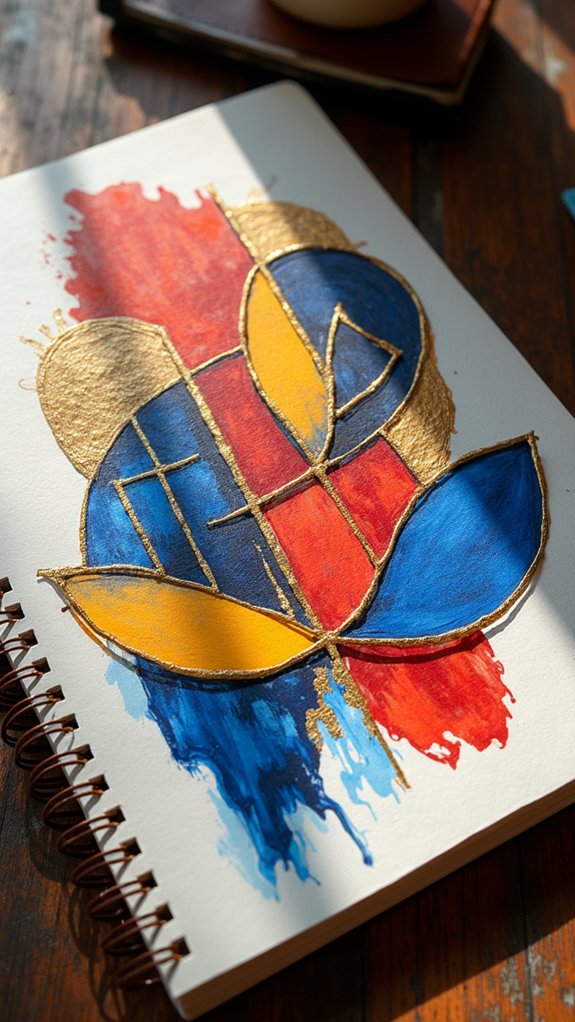
Ever wonder why some abstract art just seems to jump off the page with energy? It’s all about the way artists use shapes and patterns. Geometric shapes—think circles, triangles, and squares—can be arranged and overlapped in bold, eye-catching ways. Patterns, like repeating lines or zig-zags, bring rhythm and make your art dance. Want to see how these elements work together? Check out the table below for ideas:
| Shape | Pattern | Technique |
|---|---|---|
| Circles | Dots | Vary line thickness |
| Squares | Checkerboard | Layer with paint |
| Triangles | Stripes | Try mixed media |
Using just a few colors helps the shapes and patterns stand out. Adding cool textures, like bumpy lines or collaged paper, really pumps up the excitement!
Imaginative Character and Creature Design
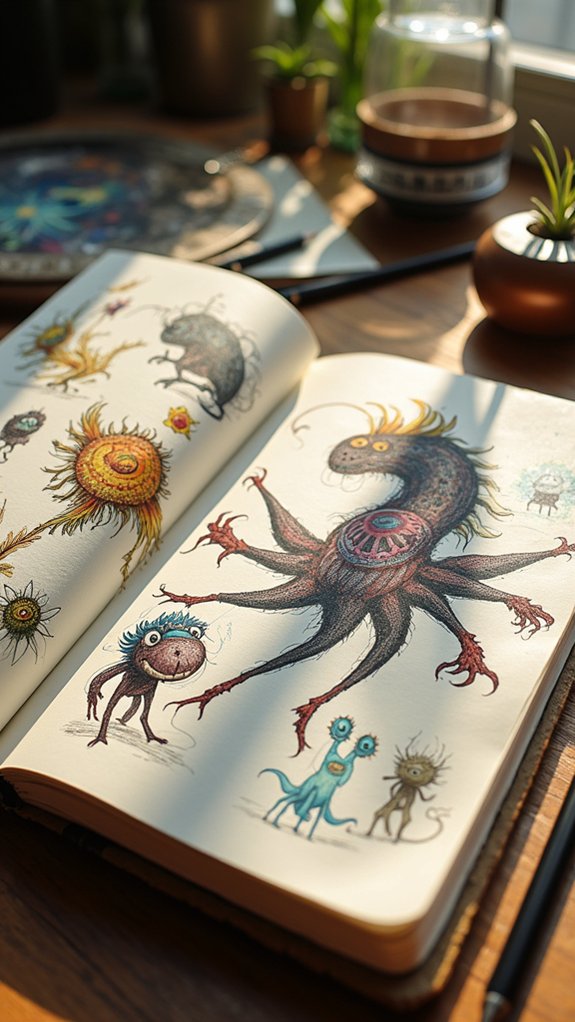
A little imagination can turn an ordinary sketchbook page into a stage bursting with wild characters and unbelievable creatures. Imaginative character design is like creating a friend out of thin air, complete with their own quirks and weird hobbies.
Artists can mix together pieces from fairy tales, legends, and even their favorite cartoons to spark innovative creature designs that no one’s ever seen before! Playing around with different drawing styles, from goofy cartoons to angular Cubism, keeps things exciting and unexpected.
Plus, using reference images can help mash all those wild ideas into one awesome drawing, full of personality and flair.
- Try sketching characters with silly expressions or wild poses.
- Mix up two folklore creatures for something brand new.
- Draw in a totally unfamiliar art style.
- Invent unusual backstories for each design.
Challenging Transparency: Glass, Water, and Reflections
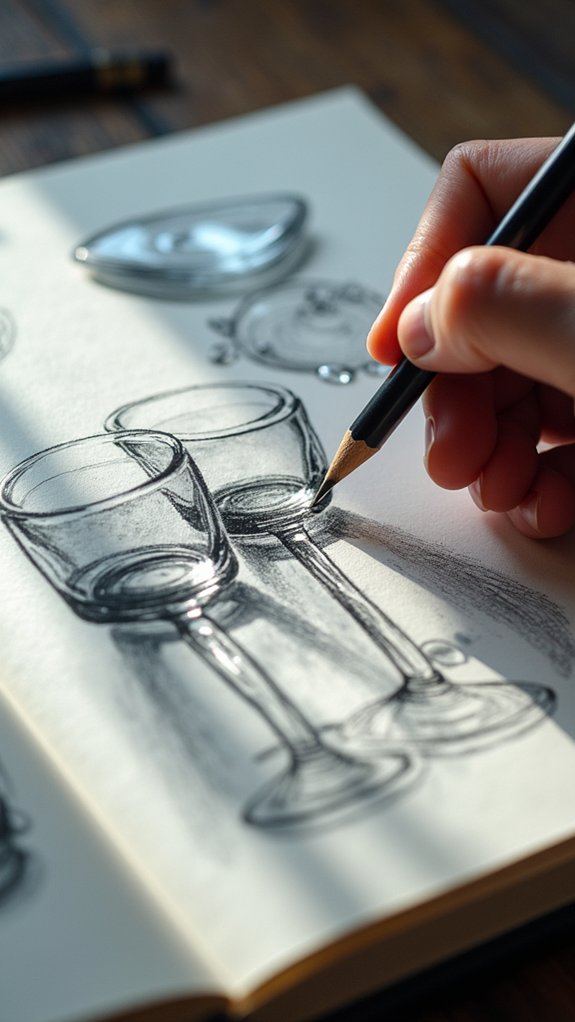
After filling pages with wild characters and out-of-this-world creatures, artists can really put their skills to the test by sketching things that are almost invisible—like glass, water, and shiny reflections.
Capturing transparency is kind of like trying to draw something made of nothing. For glass, pay attention to how light bends and bounces, making the surface seem both there and not there.
Water is even trickier; it wiggles, shifts, and carries reflections of whatever’s nearby. Drawing water calls for sharp observation—notice the ripples, waves, and unexpected shapes.
Learning about light, shadow, and using tricks like cross-hatching or layering will help nail the effect. Messing with contrasting shades or colors adds extra punch, making these see-through wonders jump off the page!
Revisiting Masterworks: Personal Interpretation Studies
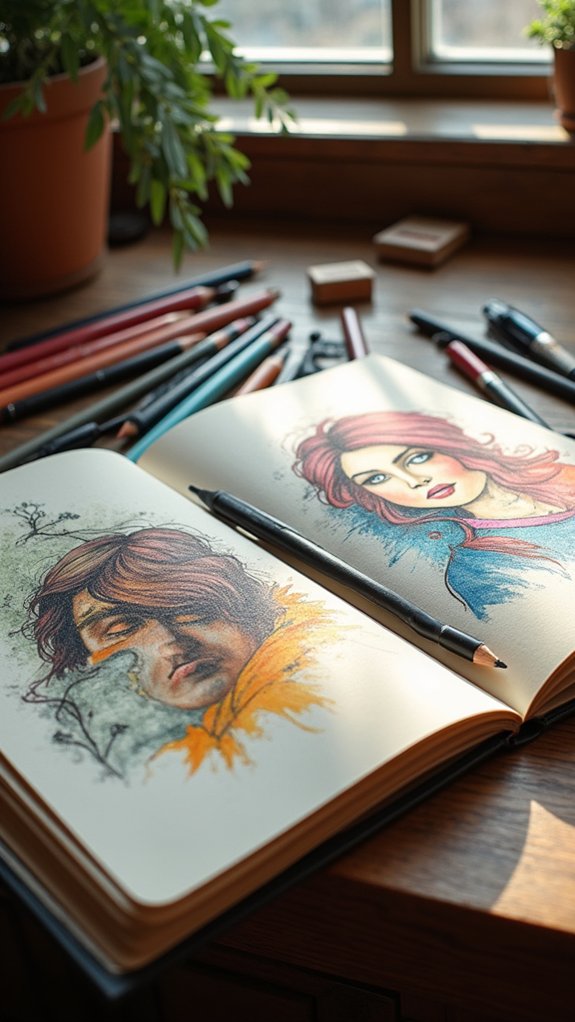
How did artists from hundreds of years ago make their work look so amazing—and what could a sketchbook explorer learn by stepping into their shoes?
Revisiting masterworks isn’t just about copying; it’s a ticket into the minds of art legends. Digging deeper, personal interpretation studies let artists add their own spin, kind of like remixing a classic song with new beats or feelings.
This practice makes you observe every brushstroke, color choice, and sneaky bit of composition, sharpening your art radar. And hey, switching up mediums, from charcoal to watercolor, helps you find your own groove. Plus, it’s a cool way to build a sketchbook that’s both a tribute and a showcase of your growth.
- Study real masterworks in books or online
- Try different mediums for each version
- Add your own details, colors, or twist
- Compare your piece with the original—spot the differences!
Seasonal Inspirations: Drawing Through the Year
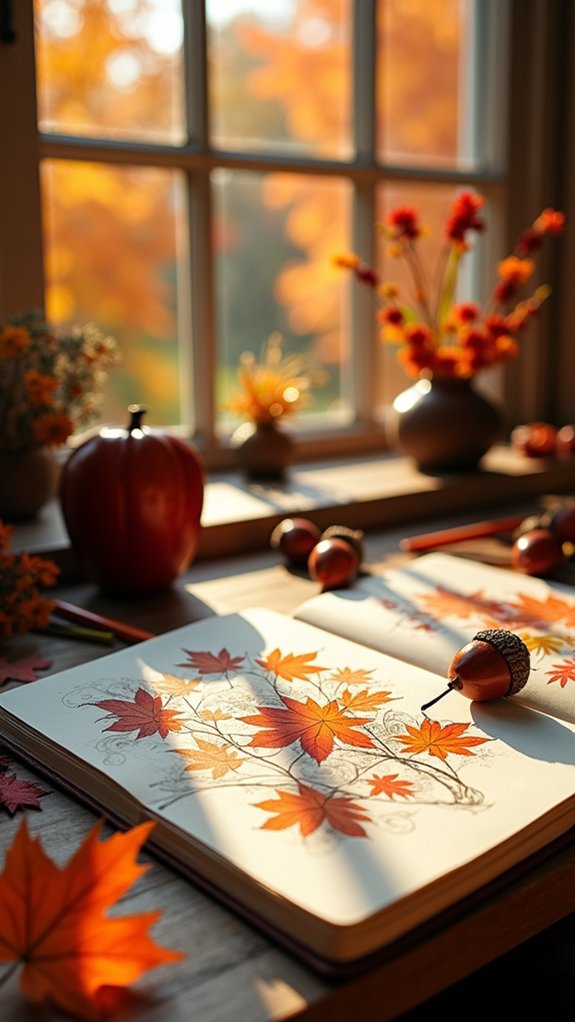
Ever notice how the world looks totally different with each season? That’s what makes seasonal inspirations such great subjects for sketchbooks. Spring bursts with wildflowers, summer is all about beach days, fall shows off blazing leaves, and winter transforms everything into a frosty wonderland. Each season offers totally new colors, activities, and moods to capture. Sketching sled rides, sunbathing, or even holiday parties pushes artists to try out drawing movement and explore cultural details. Drawing seasonal fruits or blooming flowers can help sharpen those observation skills, too. To compare what stands out each season, check out the table below:
| Season | Activity | Colors/Elements |
|---|---|---|
| Spring | Flower picking | Pinks, greens, yellows |
| Summer | Beach volleyball | Blues, sand tones |
| Winter | Sledding | Whites, deep blues |
Expressing Emotion With Lines and Color Choices
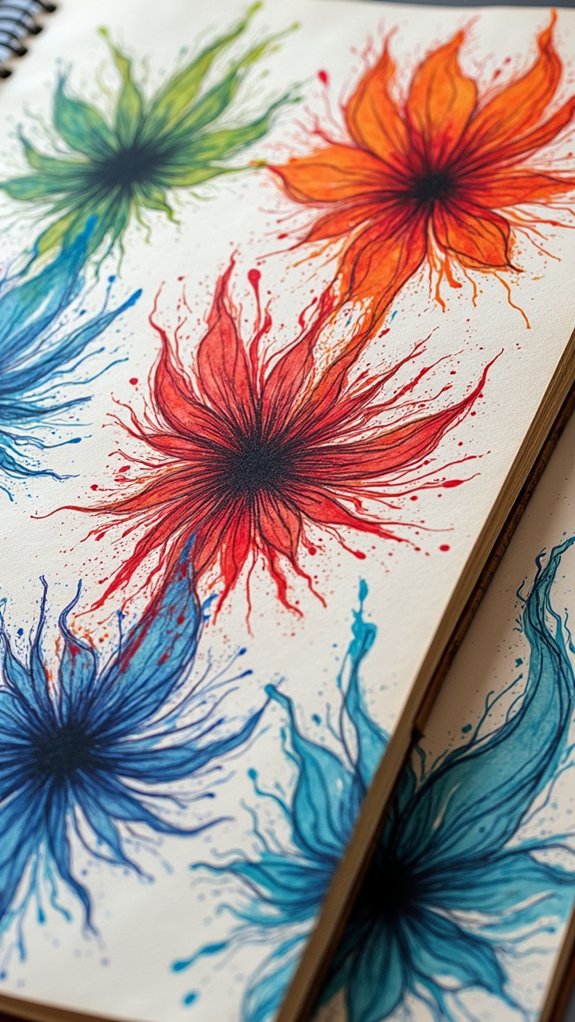
The seasons might change what’s happening outside, but inside a sketchbook, it’s all about feelings and the wild ways to show them. Lines and color choices act almost like your secret code, sending emotions straight from the page to anyone who looks.
Curvy, smooth lines might spread chill vibes, while sharp, zigzaggy ones scream drama or chaos. Picking colors is a big deal too—some shades pack tons of energy, while others feel cool, calm, or even a bit sad. Mixing up line thickness makes things interesting, and combining wild color bursts with quiet, muted tones gets people thinking or even grinning.
- Jagged lines = tension, chaos
- Soft, flowing lines = calm, peaceful vibes
- Warm reds/oranges = energy and warmth
- Contrasting vibrant and muted colors = emotional conflict
Urban Sketching: Buildings, People, and Street Life

While most folks see city streets as just places to rush from one thing to the next, urban sketchers see every sidewalk, building, and stranger as a possible story waiting to be drawn. Urban sketching is all about catching the action and vibe of street scenes—crowded crosswalks, old brick buildings, and that one dog that looks like it knows everyone. Artists who immerse themselves in this art form usually sketch right on the spot, where real life is their classroom. Adding in cars, bikes, or even a vendor’s cart, their pages come alive with city noise. Imperfections? Those make it better! Sometimes, a quick doodle of someone hailing a cab says more than hours of careful work.
| Buildings | People | Street Life |
|---|---|---|
| Towers and bricks | Walking in groups | Buses and bright lights |
| Doors and windows | Laughing together | Street musicians playing |
| Old fire escapes | Kids on scooters | Banners and food carts |
| Modern glass walls | Tourists taking pics | Morning joggers rushing by |
| Junky rooftops | Friends hanging out | Pets tugging leashes |
Frequently Asked Questions
What Makes a Drawing Stand Out?
A drawing stands out through intentional composition techniques and bold color choices. Strategic arrangement of elements and dynamic perspectives, combined with striking hues or contrasts, capture attention and invite viewers to engage with the artwork on a deeper level.
How Do I Make My Sketchbook Unique?
To make a sketchbook unique, one should focus on developing personal style and incorporating varied artistic techniques. Experimentation with diverse materials, creative references, and thoughtful annotations helps guarantee each page reflects an individual’s evolving artistic journey and imagination.
What to Draw 100 Ideas?
When considering what to draw, artists can explore abstract concepts, nature patterns, whimsical creatures, urban environments, fantasy worlds, everyday objects, historical figures, mythical beings, seasonal themes, geometric shapes, animal portraits, personal stories, creative challenges, and unique self-expression themes.
What Can a 9 Year Old Draw?
When considering what a 9-year-old can draw, options include animals in nature, which fosters observation skills, or characters from a favorite cartoon, encouraging creativity. Drawing these subjects allows for both imaginative expression and practicing fundamental artistic techniques.
Conclusion
So, whenever ideas run dry, your sketchbook doesn’t have to look boring or just plain empty. There’s a whole world of things you can draw—upside down, mixed up, or colored wild—just waiting to leap from your mind onto the page. Mess around with these ideas, try something weird, and don’t stress about perfect lines. Remember, art is about fun, surprise, and seeing things differently. So grab your pencil, get drawing, and let your imagination loose!

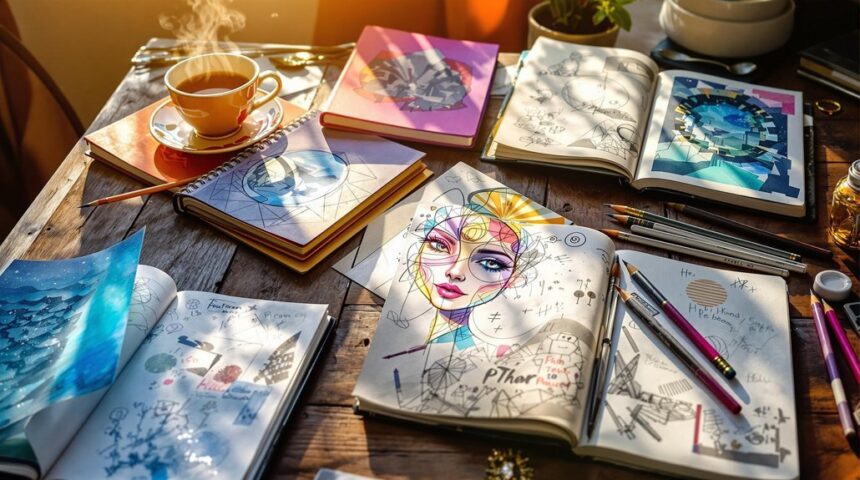
Leave a Reply